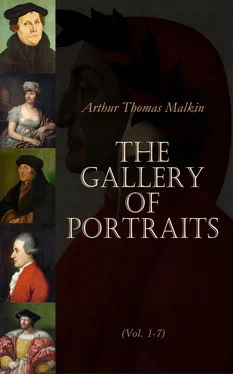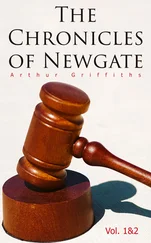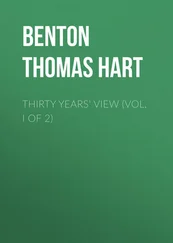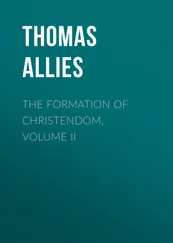Of these three series, the Homeric is the most popular. This preference may, perhaps, be accounted for by the Grecian poem being more generally familiar than that of Dante: yet the subject of the Divina Commedia in many respects appears to have been more congenial to the talents of the artist; and perhaps an impartial judgment will pronounce, that of all the works of Flaxman, the designs from Dante best exhibit his peculiar genius. During his stay at Rome he executed for Frederick, Earl of Bristol and Bishop of Derry, a group in marble, which consisted of four figures larger than life, representing the fury of Athamas, from Ovid’s Metamorphoses: by this he lost money, the price agreed on being only six hundred guineas; a sum insufficient to cover the expenses of the work. The recollection of this piece of patronage was so disgusting, to use the word by which he himself once characterized it, that in after life he could not bear to talk on the subject.
Whilst in Italy he made numerous drawings and memoranda upon ancient art, which afterwards formed the groundwork of his lectures on sculpture. After an absence of seven years he returned to England, and engaged a house in Buckingham-street, in which he continued to reside till his death.
His first great work after his return was a monument to the Earl of Mansfield. In 1797 he was elected an associate, and in 1800, a member of the Royal Academy, to which he presented, on his admission, a marble group of Apollo and Marpessa. He visited for a short time, in 1802, the splendid collections of the Louvre, in order to revive his early recollection of the works of art which had been brought from Rome. In 1810, a professorship of sculpture having been established by the Academy, he was elected to fill the chair, and his lectures were commenced in 1811. Those who had formed high expectations of eloquence, and of felicity of diction and illustration, were disappointed. The sedate gravity of his manner, his unimpassioned tone, and the somewhat dull catalogue of statues and works of art which he occasionally introduced, conduced to tire a general audience. But the ten lectures, which have been published since his death, must always furnish an important manual to every student in sculpture. The lectures on Beauty, and the contrast of Ancient and Modern Sculpture, are peculiarly interesting, and embody nearly all which can be said on the leading principles of art. In addition to these lectures he wrote several anonymous articles, which are enumerated by Mr. Cunningham. These were the ‘Character of the Works of Romney,’ for Hayley’s life of that artist, and either the whole or part of the articles, Armour, Basso-relievo, Beauty, Bronze, Bust, Composition, Cast, Ceres, in Rees’s Cyclopædia. Many of the opinions put forth in these different essays he has embodied in his lectures.
Besides the designs already noticed, he executed numerous illustrations of the Pilgrim’s Progress, forty designs for Sotheby’s translation of Oberon, and thirty-six designs from Hesiod, illustrating the story of Pandora, and exhibiting the effects of her descent on earth. The subjects from Hesiod were those in which his poetic fancy appeared most to delight.
In 1820, Flaxman lost his wife, with whom he had lived in uninterrupted happiness for thirty-eight years, and from the effects of this bereavement he seemed never entirely to recover. A beloved sister, and the sister of her whom he most loved, remained to him, and continued his companions till his death.
At the time of this domestic misfortune the artist was in the zenith of his fame. Commissions poured in, and among them, one order especially worthy of his talents, for a group of the Archangel Michael vanquishing Satan, given by the Earl of Egremont, a nobleman who has omitted no opportunity of patronising the fine arts in this country. This group exhibits more grandeur of conception than any work of art of modern times. Unfortunately the marble of which it was cut was much discoloured, and the work was not entirely finished at his death. Amongst the finest of Flaxman’s later productions, Mr. Cunningham enumerates his Pysche, the pastoral Apollo (also in the possession of Lord Egremont), and two small statues of Michael Angelo and Raphael. But the most remarkable of them is the shield of Achilles, designed and modelled for Messrs. Rundell and Bridge, the silversmiths. The diameter is three feet, and the description of Homer has been strictly followed. In the centre is the chariot of the sun, in bold relief, almost starting from the surface, surrounded by the most remarkable of the heavenly bodies: around the rim is rolled the ever flowing ocean. The intermediate space is occupied by twelve scenes, beautifully designed in conformity with the words of the poet. For this the artist was paid £620. Four casts of it in silver were taken, the first for the late King, another for the Duke of York, the third for Lord Lonsdale, the fourth for the Duke of Northumberland.
Flaxman died on the 7th of December, 1826, of an inflammation of the lungs, the result of a cold. In person he was small, and slightly deformed, but his countenance was peculiarly placid and benign, and greatly expressive of genius. His dress, manners, and mode of life were simple in the extreme: he was never found at the parties of the rich and great, and mixed little even with his professional brethren. His life was spent in a small circle of affectionate friends, in his studio, and in his workshops, where those whom he employed looked up to him as a father.
Amongst the different classes of his works, the religious and the poetic were those in which he chiefly excelled. The number of pure and exalted conceptions, which he has left sketched in plaster or outlined in pencil, is quite extraordinary. “His solitude,” observes Sir Thomas Lawrence, “was made enjoyment to him by a fancy teeming with images of tenderness, purity, or grandeur. His genius, in the strictest sense of the word, was original and inventive.” Among the most important of his works not before noticed, is his monument to the memory of Sir Francis Baring, in Mitcheldever Church, Hants, a work of exquisite beauty, both in design and expression, embodying the words, “Thy kingdom come—thy will be done—deliver us from evil.” He also executed, among others, monuments to the memory of Mary Lushington, of Lewisham, in Kent, to the Countess Spencer, to the Rev. Mr. Clowes, of St. John’s Church, Manchester, and to the Yarborough family at Street Thorpe, near York. This last, and one to Edward Bulmer, representing an aged man instructing a youthful pair, Flaxman considered the best of his compositions.
He executed several historical monuments to naval and military commanders. These deal too largely in emblems and allegories, Britannias, lions, victories, and wreaths of laurel, to add much to the reputation of the artist: especially as his forte lay in the exquisite feeling and grace of his conceptions, not in manual dexterity of execution; the chief merit to which such cold and uninteresting productions can lay claim. He executed statues of Sir Joshua Reynolds; of Sir John Moore, in bronze, of colossal size, for Glasgow; of Pitt, for the Town-Hall of the same city; of Burns; and of Kemble, in the character of Coriolanus. That of Sir Joshua Reynolds (one of his earliest) is perhaps the best. Many of his works were sent abroad: for India he executed a statue of the Rajah of Tanjore, and a monument to the celebrated Schwartz; two monuments in memory of Lord Cornwallis, a figure of Warren Hastings, and a statue of the Marquess of Hastings.
Since the death of Flaxman, six plates have been published by his sister, from his designs. The subjects are religious; the engravings are admirable fac-similes of the original drawings, which were made in his best time; and perhaps there is no published work of his more illustrative of the peculiar taste and genius of the artist.
Читать дальше












